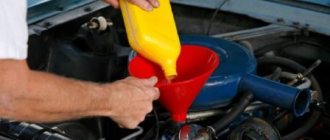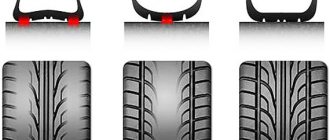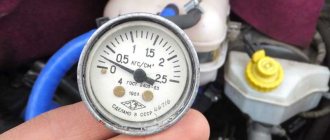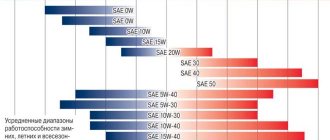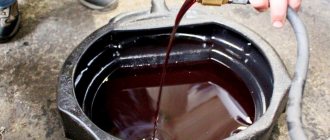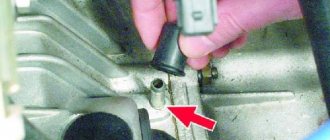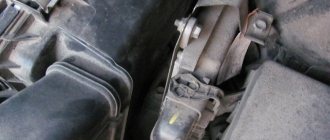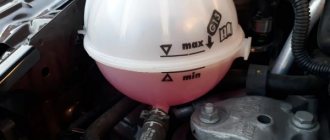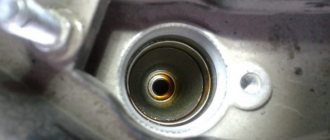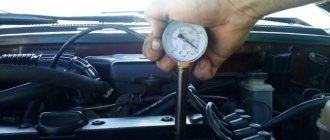Why does engine oil leak?
So, if the driver regularly monitors the lubrication level, then it will immediately be noticeable that the oil has left the engine. In this case, oil consumption is usually affected by two factors: engine oil leakage and oil burnout.
- Let's start with the most common reasons. For example, a breakdown of the cylinder block gasket occurs in the event of incorrect assembly of the engine and improper crimping of the cylinder head. The result is that the cylinder head is not evenly pressed against the cylinder block through the gasket, which leads to breakdowns in places where the cylinder head is loosened. The car owner can identify this malfunction with the naked eye by leaks of engine oil from under the cylinder head.
Also, a breakdown of the cylinder head gasket can also result in coolant entering the engine crankcase. In this case, this will be signaled by the appearance of an emulsion in the oil sump. When removing the oil dipstick from the engine crankcase, you can observe an increase in the oil level and an uncharacteristic whitish tint for oil (emulsion).
In this situation, under no circumstances should you start the engine, in order to avoid wear on the crankshaft liners, increased wear on the camshaft cams and scuffing on the mirror surface of the cylinder liners.
To solve the problem, it is better to deliver the vehicle by tow truck to the place of repair and replacement of the cylinder head gasket. It is also a mistake to believe that without replacing the gasket, additional tightening of the cylinder head will give results. The fact is that since the head gasket is already deformed, there will be oil leaks at the deformation sites.
A mandatory measure in this situation is to flush the lubricating lines from emulsion residues with flushing oil, after which the oil recommended by the engine manufacturer is poured into the engine.
For the information of car owners, motor oils of inexpensive brands, but with the appropriate viscosity coefficient, can be used as flushing oil. This will not cause any harm to the internal combustion engine, since the duration of operation of the engine on cheap oil is not significant, the loads are minimal, and the task of such a lubricant is to flush the engine from the emulsion. At the same time, savings on the car owner’s budget are obvious.
- Worn crankshaft oil seal (front or rear) is also a fairly common cause of engine oil leakage. This problem can sometimes be easily diagnosed by an oil puddle under the car or drips. However, in some cases, obvious leaks are not always visible without examining the lower part of the car.
The crankshaft oil seal is made of rubber, but it is not durable and is subject to various influences (elasticity is lost, wear appears, rubber is subject to mechanical wear by abrasive debris contained in engine oil, etc.). In this situation, the solution to the problem is obvious. The crankshaft oil seal needs to be replaced. It is also recommended to fill with fresh engine oil and change the oil filter.
- Oil leakage from under the oil filter gasket or from the oil filter housing is also on the list of possible causes for a decrease in the oil level in the engine crankcase. The problem arises as a result of incorrect installation of the oil filter (under-tightening or overtightening, as well as abrasive dust getting on the filter gasket). A factory defect in the oil filter is also possible (oil may leak in places where the filter housing is rolled).
The problem is solved by replacing the oil filter. If the filter is not tightened enough, then you need to try tightening it more. By the way, in order to avoid deformation of the rubber gasket of the oil filter, experts recommend lubricating this gasket with oil before installing it.
- Failure of oil seals (oil seals) can also lead to a drop in the oil level in the engine crankcase. This part is made of oil-resistant rubber. Over time, under the influence of pressure and high temperatures, rubber loses its elasticity and, accordingly, ceases to function as a seal.
As a result, the tightness of the gas distribution mechanism valve seals is lost and the engine oil flowing through the leaky valve seals flows down the guides and enters the internal combustion engine cylinders. The lubricant then burns along with the fuel. Engine oil combustion products have a detrimental effect on the performance of piston parts. The problem can be resolved by replacing the valve stem seals.
- The occurrence of oil scraper rings leads to poor removal of the oil film from the inner surface of the cylinder during the piston stroke. As a result, the oil remaining in the combustion chamber actively burns out, forming coke deposits.
Such deposits lead to coking and ring formation. The result of this is a decrease in the compression level, a drop in the power of the internal combustion engine and uneven development of the working surface of the cylinders (ellipse), which entails expensive repairs with boring or lining the cylinder block, as well as the need to perform work to replace the piston rings.
Where does the engine oil go: hidden reasons
Let's start with the fact that in addition to the obvious reasons for increased lubricant consumption (oil leakage), there are also indirect ones. For example, an internal combustion engine cooling system.
In simple words, a number of malfunctions in the engine cooling system, insufficiently efficient operation of this system can also lead to the so-called “oil burn”.
The reason is that insufficient heat is removed from the engine, the engine in turn becomes “hotter”, i.e. its operating temperature is forcibly increased by several degrees and the internal combustion engine operates at the upper temperature limit.
The oil recommended for use in various engines, according to its technical characteristics and tolerances, is designed to operate at lower temperatures, namely at the nominal temperature conditions of the internal combustion engine.
Accordingly, being constantly exposed to extreme temperatures, the oil intensively “burns”, and the waste products clog the oil channels, reducing the efficiency of the entire engine lubrication system.
- Oddly enough, problems in the power system can also indirectly provoke increased engine oil consumption. The problem lies in the fuel injectors, which, without proper maintenance, over time begin not to spray the fuel mixture, ensuring uniform ignition in the cylinder, but pour fuel in a stream.
As a result, uneven combustion of fuel begins and increased detonation. In turn, increased detonation leads to the appearance of microcracks in the pistons and piston rings, as well as cylinders (liners). Due to these defects, oil scraper rings do not effectively remove the oil film from the working walls of the cylinders. It turns out that oil breaks into the combustion chamber with all the ensuing consequences.
Incomplete combustion of fuel
Increased waste is one of the main reasons for increased engine oil consumption. This problem is most often a consequence of wear of various engine parts, primarily the cylinder-piston group. Excessive amounts of fuel in the combustion chamber can contribute to premature wear of cylinders, pistons and rings. Excess fuel that does not have time to burn washes away the oil film, leaving friction pairs unprotected. This situation can be caused by malfunctions of the ignition system and fuel injectors. You should also avoid refueling your car with low-quality fuel.
Where does the oil go?
In many ways, the problem with high oil consumption is associated with the design of modern engines, which have a high compression ratio, which makes it easier for gases to escape through the piston rings. In addition, most modern engines are turbocharged, and some oil inevitably gets into the supercharger.
Therefore, one of the most common reasons for a decrease in engine oil volume is its waste. The lubricant simply burns along with the fuel, depositing black soot on the walls of the pistons and cylinders.
Photo: oil-mirny14.ru
Obvious reasons why oil leaks
Cylinder head gasket failure
As a result of improper engine assembly, the head is pressed unevenly against the cylinder block, causing gasket breakdown. The malfunction can be determined visually: oil streaks will be visible from under the cylinder head.
Also, if the cylinder head gasket breaks, antifreeze can enter the engine crankcase and mix with the oil. In this case, there will be an increased oil level on the dipstick and an emulsion on the dipstick and plug.
It will be useful: Polishing a car after painting it yourself video
You cannot start such a motor! It is better to deliver such a car by tow truck to the place of repair and replacement of the cylinder head gasket. Be sure to also change the oil and filter, and before that, flush the lubrication system.
Crankshaft oil seal wear
This problem is easy to identify: there will be an oil puddle under the car or the exhaust will take on a bluish tint. But sometimes, for an accurate diagnosis, you will need to carefully examine the underbody of the car.
Since rubber is used to make the crankshaft oil seal, which is subject to mechanical wear over time, the best solution is to simply replace the oil seal. And also for preventive purposes, after replacing the oil seal, it is recommended to fill in new engine oil and replace the filter.
Oil leak from under the filter
If the oil filter is not tightened or tightened during installation, there will be a leak. Another option is when oil leaves the crankcase due to a defective oil filter, flowing through its housing. A leak can also be the result of a manufacturing defect.
In any case, the filter should be replaced, and if it is not clamped tightly, tighten it.
Failure of oil seals
Oil-resistant rubber loses its elasticity over time and when exposed to high temperatures and stops working properly. As a result, the tightness of the timing valve seal is broken, the oil, flowing through the leaky oil seal, enters directly into the cylinders and burns with the fuel. In addition to oil starvation, this harms the piston group parts.
The problem is solved by replacing the valve stem seals.
Occurrence of oil scraper rings
When the oil scraper rings are stuck, the oil film during the stroke of the piston in the cylinder is difficult to remove from the walls. As a result, the remaining oil burns out, forming deposits in the combustion chamber. This further aggravates the problem of ring sticking, the engine loses power, and uneven wear of the cylinder surface threatens the need for boring or lining the block, or replacing the piston rings.
Piston group wear
The engine loses power and accelerates the car worse, and oil consumption is slowly but surely increasing - it is necessary to check the compression in the cylinders. If the readings are low, it means the oil is leaving due to natural wear of the piston group. This is typical for engines with high mileage that are not well maintained.
Hidden reasons for the “oil glutton”
A malfunction that is invisible at first glance can also lead to oil burns. Therefore, the hidden reasons for a sharp drop in oil level also need to be known.
"Hot" engine operating mode
When not enough heat is removed from the internal combustion engine, it has to operate at the upper temperature limit and the engine remains “hot”. Due to such a forced increase in temperature, the internal combustion engine operates at the maximum permissible temperature, the oil intensively “burns”, deposits of such carbon deposits clog the oil channels, interfering with the normal operation of the lubrication system.
This problem is especially typical for modern oil scraper turbodiesels.
Wear of turbine seals and bearings
When there is play in the bearings and wear of the seals, the engine oil, which is supplied under pressure to the turbines, immediately enters the combustion chamber. And if the passage of the turbine is clogged with carbon deposits, then the oil, after being sucked into the combustion chamber, ends up in the exhaust pipe. To solve the problem, you will have to repair the turbocharger.
Fuel system malfunctions
Without regular maintenance, the fuel injectors of a diesel internal combustion engine begin to pour fuel in a stream instead of a soft spray, which causes uneven combustion of fuel in the cylinders and detonation.
Increased detonation leads to microcracks in the pistons and piston rings and cylinders. Such defects prevent the oil scraper rings from removing the oil film from the cylinder walls evenly and completely; the remaining oil burns out in the combustion chamber.
Worn high pressure fuel pump
In some cars, fuel injection pump parts are lubricated with oil rather than diesel fuel. When fuel pump parts wear out, oil consumption increases.
Increased crankcase gas pressure
Often this malfunction is caused by wear of parts of the piston system or valve guides. Crankcase gases enter the combustion chamber, accelerating oil combustion and increasing its consumption. This problem can only be solved by replacing the motor.
Malfunction of the crankcase ventilation system
High oil consumption can be caused by valve contamination due to poor ventilation. Cleaning the filter or ventilation duct can solve this problem.
You will learn how to independently determine diesel engine malfunctions from this article.
You will find diesel fuel injectors in our catalog
Diesel Craft LLC DIESEL FUEL EQUIPMENT Registration number in the Trade Register 392854
Symptoms
The first cause for concern is that the engine was not consuming oil and suddenly started. However, before looking for a serious malfunction, think about whether your driving style has changed. Maybe you used the car on a long route with a full load, or often made short trips? In this case, a slight loss of oil does not usually indicate a problem. Or maybe you delayed changing the oil, and it has already aged and lost its properties?
The next step is to look under the car. Large oil leaks usually show up as marks on the ground. True, there are leaks (for example, from under the shaft seal) that do not leave stains. Oil can collect in the nooks and crannies of soundproofing mats or on the engine guard.
The second cause for concern is that the oil began to disappear immediately after the change. In this case, start by checking the filter housing because a sloppy mechanic may not have tightened it properly.
However, more often the reason is different - incorrectly selected oil. Modern engines are very sensitive to its parameters. In addition, manufacturers are increasingly using oils with a very low viscosity coefficient, so-called energy-saving ones, for example, 0W-20. They have lower internal resistance and therefore save fuel. However, this lubricant penetrates rings and seals relatively easily.
Incorrect oil
Let's start with easily removable reasons. One of them is not quite suitable oil, when used, increased waste is observed. There is a similar example in our personal practice: a middle-aged Volvo with a working “turbo-five” (even compression in all cylinders, a turbocharger in good health, no leaks through the seals) spent clearly above the norm and, as they say, out of the blue - with a calm driving style.
Shutterstock/VOSTOCK Photo
What was surprising was that its parameters corresponded to the manufacturer’s recommendations. Switching to oil with increased high-temperature viscosity completely solved the problem. As an experiment, the choice fell on the products of another, more well-known and well-established brand. However, we will not exclude the possibility of a decrease in oil waste on products of the same brand, but with a higher viscosity.
It will be useful: Nissan x trail t31 door does not open
White explosion
The real problems can start if oil gets on electrical wires or on the rubber hoses of the engine cooling system. A few drops are enough to cause big trouble.
Modern synthetic oil is impregnated with chemical elements that eat away deposits and clean the engine from the inside. In addition, the lubricant base itself is incompatible with a number of plastics and rubber products. Oil mercilessly breaks down their structure. The drop is absorbed, then the rubber swells, loses elasticity and over time cannot bear the load.
The swollen pipes of the cooling system burst under pressure, the antifreeze instantly boils and bursts out in giant clouds of white steam. The driver thinks that the engine has exploded and he stops in panic. You can’t drive any further; you’ll have to park on the side of the road, put up a warning triangle and go to the spare parts store for new rubber tubes.
As for the wiring, its rubber also absorbs oil, hardens and cracks due to temperature differences.
Valve mechanism
Another common reason for the penetration of lubricating fluid into the combustion chamber is wear of the valve guides, as well as valve stem seals, which are responsible for preventing oil from entering the chamber. In addition, the caps lose elasticity over time and lose their ability to perform their functions. When replacing them, you need to check the condition of the guide bushings. Excessive wear of these parts leads to increased valve play, which means that new caps will quickly fail and lubricant will again enter the combustion chamber.
Is it normal to eat oil?
It turns out that modern car owners have no choice but to come to terms with the need to regularly check the oil level in the engine and add it as necessary. However, the car’s oil appetite can be somewhat moderated by doing more frequent maintenance and adhering to a calm driving style.
Normal oil consumption is considered to be approximately 0.5 percent of gasoline consumption. In other words, if during a service interval of 15 thousand kilometers your car has consumed 1200 liters of fuel, then normal oil consumption will be 400 grams of oil per 1 thousand kilometers.
What happens if you drive without oil in the engine?
Is it possible to drive a car when there is no oil in the engine?
Engine oil lubricates all moving parts to reduce friction and prevent rapid wear. So, will the engine run without oil?
Driving a car when there is no oil in the engine will definitely lead to instant wear of any engine parts. At low speeds, if you are very lucky, you may be able to drive without noticeable consequences, especially if the engine is new, but most likely you will soon hear a knock or squeak from under the hood. This will mean that the crankshaft journal has begun to come into contact with the bearings. Further, if you do not stop in time, the engine may simply jam and require major repairs.
Also, a knocking sound may mean that the engine bearings have rotated. In any case, it is not recommended to continue driving and you should immediately contact service for help. And then you might be able to get away with relatively inexpensive repairs.
To keep the engine in good condition and in good condition, it is recommended to check the oil level at least once a month, or better yet every two weeks, and top up if necessary.
This procedure will not take much time, but will save a large amount of money, time and nerves.
Get your car serviced and diagnosed more often, so your car will serve you for a long time and without problems.
Source
Unclosed lid
There are other cases associated with errors when pouring oil into the engine. Sometimes drivers do not close the filler cap correctly. This lid has latches that hold pressure during operation. But if the cap is not tightened completely, it may break off.
Then the oil circulating in the engine will fly out in fountains through the open hole. Sprays fly far, especially when the crankshaft spins above 3000 rpm. The oil will leak into the cylinder block and head, attachments, cooling radiator with fan, and even break through to the headlights. Well, the sound insulation of the hood will be completely ruined. Then the low oil level light will come on, only then will the perplexed driver crawl under the hood and discover a leak of one and a half (approximately) liters of lubricant.
Moreover, experienced drivers often find themselves in such situations, for whom adding oil is a habitual action. Holding the canister in his right hand, the owner places the cap with the fingers of his left palm in the hope of tightening it after the topping procedure is completed. He fumbles with the canister, then wipes everything with a cloth, forgets about the loose lid, slams the hood, and then the adventure begins.
Leaking through seals and gaskets
Over time, oil can begin to leak through the seals, for example, leaving the engine by finding loopholes in the front crankshaft seal. This can happen for a variety of reasons. For example, with a high mileage of the car, when the internal part of the oil seal wears out due to vibrations of the crankshaft, long-term downtime of the car and, as a result, a dry or “hardened” part, or its poor quality or improper installation.
A leaking oil seal can damage the timing belt and must be replaced. The rear seal of the crankshaft or camshafts may leak, or it may ooze from under the valve cover or engine pan gasket. It should be remembered that dust and dirt are guaranteed to accumulate at the leak site, making its source noticeable, or after parking you will see oil drops or even a puddle on the asphalt after parking.
What to do if the oil leaves the car engine?
A motorist who neglects his vehicle and does not monitor its condition puts both himself and his passengers in danger. However, the main problem is oil leakage from the engine. In our article we will take a closer look at why this is so important and what causes this problem exist.
But before you start fixing this breakdown yourself, evaluate your knowledge and capabilities, because the engine is a rather complex mechanism. If you cannot complete this process, it is better to contact a car repair shop. But, be that as it may, every motorist should know all the signs that cause oil to leak.
What to do if you accidentally poured oil into the engine?
Overfilling the engine with oil is most dangerous when the unit is no longer new and the lubrication level significantly exceeds the maximum permissible. The fact is that a worn engine can quickly squeeze out the seals, and there is also a high probability of severe leaks.
As for new engines, the problem may not appear visually, but this does not mean that it does not exist. In this case, the oil level must be brought back to normal as soon as possible. Next, we will look at how to quickly drain engine oil from the engine yourself.
To drain excess oil from the engine, you can use the following methods:
- Pump out or drain excess oil yourself. To drain, just slightly unscrew the drain plug on the oil pan. This method is the most difficult, since it is desirable to have an overpass, pit or lift. Additionally, you will need a key to unscrew the drain plug, remove the engine protection (if equipped), as well as a container to drain excess oil.
- If it is not possible to get to the drain plug, then you can pump out some of the excess oil through the oil filler neck. To do this, you will need a special syringe for pumping (can be replaced with a medical one) and a regular rubber tube (a tube from a dropper is suitable). You can also pump out the oil using a pump or simply with your mouth. Note that in the latter case it is necessary to avoid getting the lubricant into the oral cavity. After carrying out the procedure and removing excess, check the oil level on the dipstick.
- You can also use the services of a service station or go to express oil change stations, which are usually located next to large gas stations. Specialists will quickly pump out excess oil using a vacuum for a nominal fee.
Source
These engines are prone to oil burns
Often, replacing just the rings does not solve the problem of increased oil consumption. It is necessary to check the condition of the cylinders and the block head. If necessary, they should be machined. Prices may vary depending on engine wear. If repairs are too expensive, then you should consider replacing the engine.
| Manufacturer | Engine | Cause | Price |
| Alfa Romeo (GT, GTV, 156) | 2.0 JTS | rings | OK. 50,000 rub. |
| BMW (including E46, E39, E60/61) | 2.2, 2.5 and 3.0 R6 (M54) | clogged KVKG | OK. 8000 rub. |
| Fiat (including 500, Panda, Stilo, Bravo) | 1.4 16V (Fire) | loose fit | no treatment |
| Ford (including Focus II, C-Max) | 1.8 (Duratec) | rings | OK. 30,000 rub. |
| PSA (in particular Peugeot 406, Citroen Xsara) | 1.8 (XU7) | sealant, seals, seals | RUB 16,000* |
| VW Group (in particular Audi A4/A6, VW Passat) | 1.8/2.0 T(F)SI (EA888) | poor design of pistons and rings | OK. 65,000 rub. |
| Mazda (specifically RX-8) | 1.3 (wankel) | characteristic of the design | – |
| Nissan (Almera N16, Primera P12) | 1.5/1.8 (QG) | rings | OK. RUB 48,000** |
| Opel (including Vectra C, Astra G) | 1.8 16V (Z18XE) | sealant, seals, seals | OK. 13,000 rub. * |
| Toyota (in particular Avensis T22, T25) | 1.8 VVT-i | rings | OK. RUB 57,000** |
- * – with dismantling and professional processing of the cylinder head
- ** – installation of the so-called short block (cylinder block with a crank mechanism). The cost of a “usual” major overhaul will be different.
Signs of increased engine oil consumption
All currently existing internal combustion engines use oil to reduce wear of rubbing parts. During operation, its natural consumption occurs, which mainly falls on the piston group - the oil burns, leaving deposits on the piston rings and valves. Each engine has its own oil consumption rate; it is indicated in the technical documentation and depends on the design features incorporated into it by the designers.
In a used car, increased oil consumption is determined by the following signs:
1. The engine smokes, and the exhaust gas has a bluish tint and the smell of burnt oil. This indicates wear of the piston group parts or valve seals.
2. A gradual decrease in engine power with a simultaneous drop in compression in the cylinders. At the same time, the engine begins to start poorly, especially in the cold season. These signs also indicate wear of the piston group.
3. If the engine eats oil but does not smoke, then the leak is due to poor sealing of the engine gaskets and seals. In this case, traces of oil leakage will be visible under the car and in the engine compartment.
4. In the engine itself, excess oil consumption is indicated by the condition of the spark plugs with carbon deposits on the electrodes, as well as low compression in the cylinders. Looking inside the oil filler neck and seeing a clean or yellowish engine there, we can conclude that this engine does not consume oil.
Specific reasons?
It is also worth noting other points that are not related to the design of vehicles. And the most important thing is that even a novice motorist can prevent their occurrence.
· Extreme driving. Those car owners who love fast driving, sharp braking, and all sorts of dangerous maneuvers should clearly understand that such actions greatly affect the condition of the engine. Due to the fact that the pistons experience heavy loads and the temperature rises significantly. Therefore, there are only two ways out of this situation. Firstly, you can drive normally, and secondly, you can constantly carry a can of oil and spend a lot of money on repairs;
· Turbocharger lubrication. No matter how hard you try, such losses are natural and it is extremely difficult to somehow influence them. Such losses can be found on cars with turbocharged engines;
· Poor quality oil. It all depends on the degree of viscosity; the higher it is, the better its lubricating properties. However, it contributes to additional waste in the pistons. To prevent this situation, use only licensed oil.
As for the normal level of oil consumption, there is no specific figure. However, having enough of it will save your engine from serious damage.
After reading our article, you learned where the oil can go from the engine. Useful knowledge will help you avoid high repair costs and keep your car in good condition.
Source
Permissible oil consumption rates
Most often, this should not be a cause for concern, since the car manufacturer itself declares the possibility of losing a certain amount of fluid during operation of the vehicle. Usually it is enough to simply add the missing amount.
How to check the oil level:
The level of oil consumption can be influenced by several factors: the type of internal combustion engine, its characteristics, the age of the car, the number of kilometers traveled, and the driver’s driving style.
If the need to add oil occurs frequently, there is reason to think about diagnosing the machine and identifying the causes of increased consumption.
Leakage through seals
There is usually consumption, and the problem itself can be seen by traces of oil under the car. The problem is solved by replacing the oil seals (some of which are difficult to reach, for example, the rear main shaft). You can diagnose it yourself; to do this, you need to inspect the front and rear lower parts of the engine, as well as the front and rear of the engine heads for traces of oil. If there are traces, wipe it clean and look for traces of fresh oil over time. The same applies to oil lines to the turbine and oil lines to the oil radiator.
Uhhhh. It seems like I wrote everything I remembered. If you have any questions, ask.
WE RECOMMEND ALSO READ:
Summarizing
As you can see, there are a fairly large number of answers to the question of where the engine oil goes if the car doesn’t smoke. But in order to find exactly the place through which the oil is leaking among all the probable causes, you need to conduct a thorough inspection of the engine. In this case, you can do some of the work yourself, and in some cases you need to contact service station specialists. After all, without certain equipment, oil removal may not be found.
You cannot put off solving this problem for a long time, gradually adding oil to the engine to the optimal level. After all, the car owner has no idea where the poured oil leaks and where it can cause a breakdown.
And all motorists are well aware of the cost of engine overhauls. In addition, we must not forget about vehicle safety, where any breakdown can lead to an accident.
